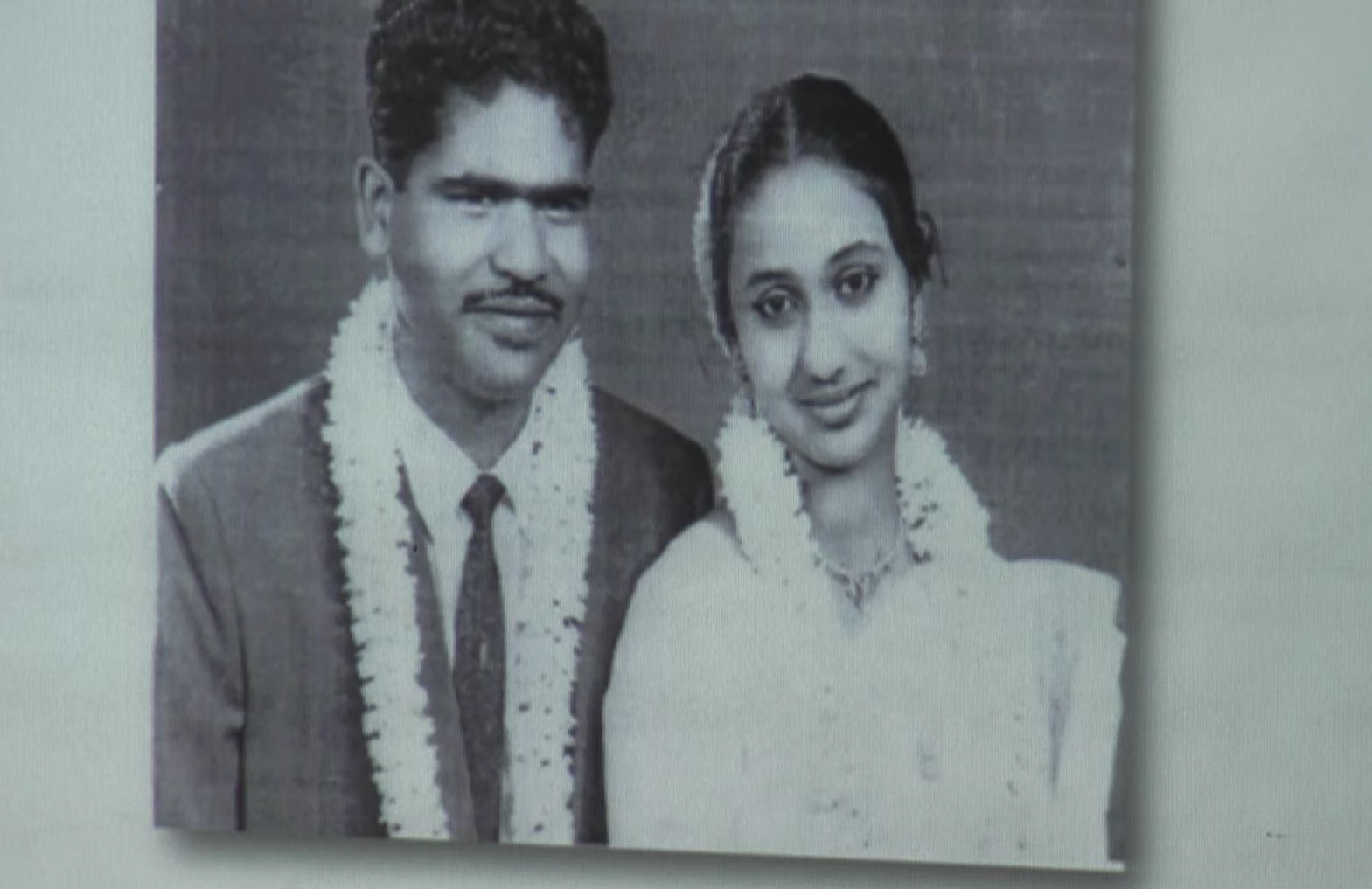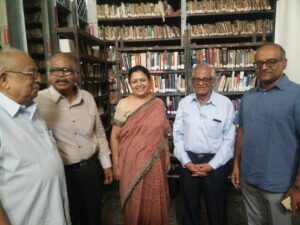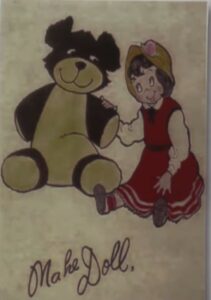His wife Mahima lost the use of all her limbs in an accident in 1972. Manohar was diagnosed with a degenerative eye condition in his thirties. Most people’s spirit would have broken at this juncture, as they lamented the terrible hand fate had dealt them. Not Manohar. Nor Mahima.

Manohar Devadoss with his Mahima during their wedding (Tamil Heritage Trust, Arkay Ramakrishnan/Screengrab from the video of a talk that Manohar Devadoss gave at THT)
Manohar Devadoss’s book Green Well Years may perhaps be my only impulse purchase of a book by an author who was, at that point, unknown to me.
I barely read two pages, flipped through a few more, and bought it with no further hesitation. I don’t know what charmed me more: the marvellous sketches in the book, the very relatable school-era episodes, or the easy flow of his prose.
Manohar passed away on Wednesday, 7 December, at the age of 85 in Chennai.
I first saw him at a Madras Day programme several years ago, but I was hesitant to approach him and introduce myself.
Then I heard Manohar’s lecture on his life and passion for art at Asan Memorial School, Nungambakkam. He was as enchanting a speaker as he was an artist and writer.
He had become almost totally blind, he said, because he had a terrible disease with a beautiful name: “retinitis pigmentosa”. What aesthetic sense must a person have, what indomitable spirit in the face of debilitating adversity, to consider the name of his affliction “beautiful”.
In one line, he put the audience at ease, telling us to not be overwhelmed by sympathy. His calm voice and measured words, with a cheerful tone and mellifluous diction, weaved magic on every audience he addressed.

Manohar Devadoss (second from left) at the Madras Literary Society library with doyens of Madras history S Muthiah (left) and KRA Narasiah (second from right), Sujatha Shankar (third from left), architect and co-author of Madras Inked with Manohar, and V Sriram (right), historian, entrepreneur, and author (R Gopu)
In 2018, he spoke at the Madras Literary Society about his love affair with books. He was introduced by KRA Narasiah, and thanked by S Muthiah, two towering doyens of Madras history. This speech included several personal references to his life, and I took notes.
As a child, he was introduced to books about trains, kangaroos, and mining lamps.
In the eighth standard, he saw a painting of an artist inspired by a muse. His mother explained who a muse was. He made a pencil sketch of Venus clothed scantily; his father, a doctor, quipped that he got the anatomy right. So art became his hobby.
Manohar studied BSc at American College in Madurai and graduated in 1956. He said he avoided moral classes at college and instead spent those hours usefully in the library.
American College’s magnificent chapel drew his attention, and he drew a picture. He realised he had an eye for perspective, and a flair for drawing with pen and ink. Thus began his lifelong passion as an artist of heritage buildings.
He wanted to get a PhD and become a professor. But he got a job in a company as a chemist making electric lamps, which were replacing Humphrey Davy mining lamps (which he remembered from his childhood).
The company sent him to England and also on holiday to London, Paris, and Rome, which was unheard of in those days. What a treat for a man obsessed with architecture and drawing!
Manohar said his value in the marriage market went up because he was foreign-returned.
Manohar Devadoss then met Mahima, a student at Stella Maris College in Madras. Romance bloomed.
They exchanged books and saw films together. One such film, To Kill a Mockingbird, had a scene where a child clutches a teddy bear.

Teddy bear that Manohar Devadoss drew for his fiancee Mahima (Tamil Heritage Trust, Arkay Ramakrishnan/Screengrab from the video of a talk that Manohar Devadoss gave at THT)
He asked Mahima if she ever had a teddy bear as a child and went to sleep clutching it. She replied, “No, but in a few days I will do so with a big teddy bear.”
This inspired him to sketch a large teddy bear and a doll. The picture of the eager teddy and this conversation featured in several of his lectures. “You can see the eagerness in the teddy bear’s eyes,” he always said.
They got married and had a daughter, Sujatha. Manohar made sketches that he distributed as Christmas cards. He drew sketch cards of the Buckingham Canal, which he said he sold at a low price. “My art was selling!” he exclaimed in delight.
A few years later, he travelled to the US to pursue a Masters degree at Oberlin College in Ohio. A liberal arts college, it had academics who studied Asia and they fit right in. After three wonderful years, they returned to India, back to working in the company.
“We had lovely plans and dreams for our life together in Madurai, but fate intervened. We had a car accident [in 1972]. Mahima was thrown out of our car, lost all her limbs, and became a quadriplegic. I borrowed books and studied all anatomy books. I learnt a lot about how quadriplegics live, what they go through. They invariably suffered bedsores, but the pictures in anatomy books couldn’t convey the smell. I made sure that she never got a bedsore during her thirty-five years she lived as such,” he said.
Mahima wouldn’t let her handicap defeat her spirit. She decided to dictate and thus write a book. She compiled simple stories into a book that was published as a supplementary reader for schools.
But destiny tested them again; he was afflicted with retinitis pigmentosa. He started going blind in his left eye. Perhaps he couldn’t continue art.
Most people’s spirits would have broken at this juncture, as they lamented the terrible hand fate had dealt them.
Not Manohar. Nor Mahima.
He started dictating Green Well Years, an autobiographical story. He added sketches to the book when he found the cataract wouldn’t totally make him blind. He spent long hours at the factory, then at home taking care of Mahima, and raising their daughter.
Mahima read book after book for hours together, while Manohar inked drawings. “Setbacks made us do more and better. I told my monster retinitis, you made me an author when I was only an artist,” he used to say.
Fortitude, is thy name Manohar or Mahima? Fortunate are those touched by such cultivated decency and indomitable cheerfulness.
Manohar gave the entire royalty to his school. Several lifelong friendships formed including at Aravind Eye Hospital. The Tamil translation of Green Well Years was published as En Madurai Ninaivugal.
Mahima passed away in 2008. Manohar wrote Mahima and the Butterfly, a tribute to his wife, with a sketch of a butterfly gracing a teddy bear’s shoulder.
His other books include A Poem to Courage, a sequel to Green Well Years; and Multiple Facets of Madurai, with marvellous pictures of various facets of the city.
His last book was Madras Inked, with several pictures of heritage buildings in Madras.
Here is a talk he delivered in 2019 titled “A Tale of Two Cities” — about Madras and Madurai — at the Tamil Heritage Trust:
Manohar Devadoss was awarded the Padma Shri by the Government of India in 2020.
“Wherever I go I hear only bad news, but wherever I go I meet only good people,” he said. And now he has gone to meet Mahima.
(R Gopu is part of the Tamil Heritage Trust (THT), and is interested in history and heritage. He is also one of the co-founders of the Varahamihira Science Forum)

Jan 09, 2024

Dec 08, 2023

Dec 03, 2023

Nov 21, 2023

Nov 07, 2023

Oct 20, 2023